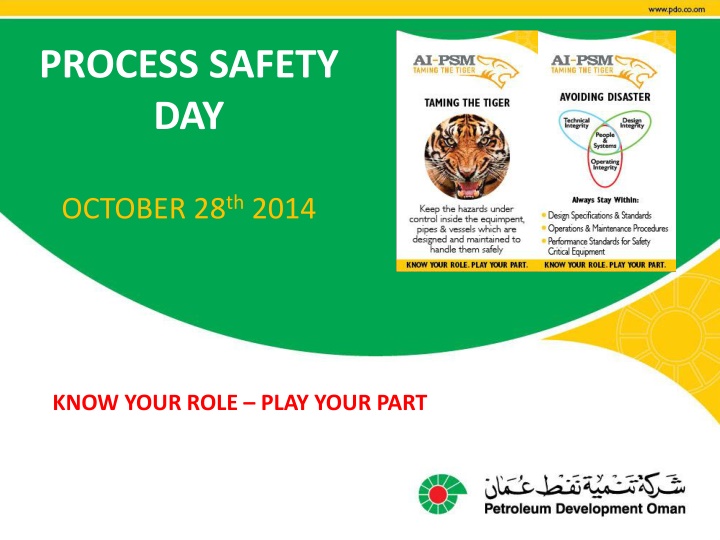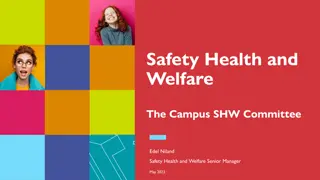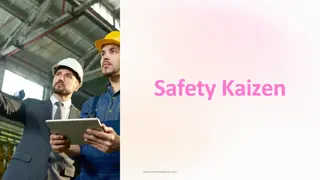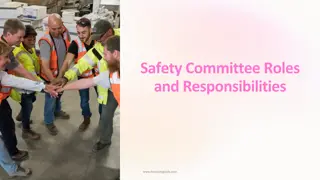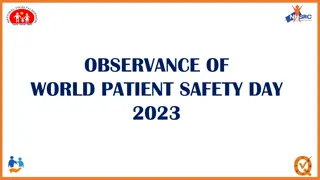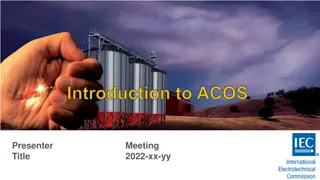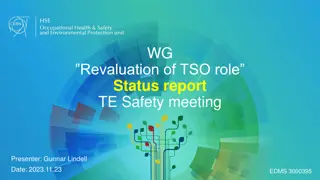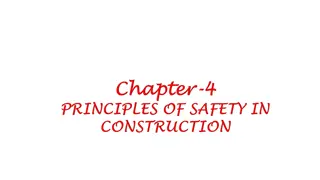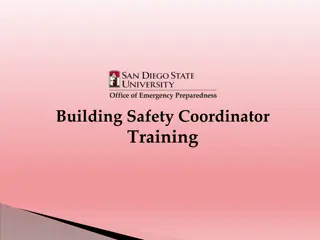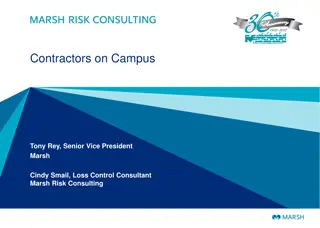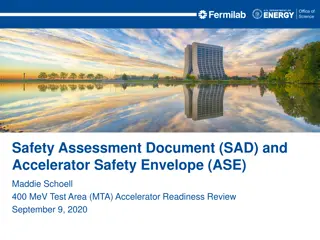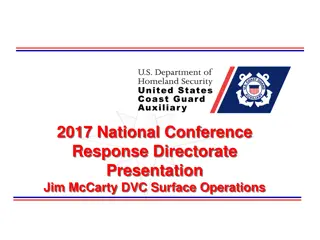Process Safety Day - Understand Your Role & Play Your Part
For Process Safety Day on October 28th, 2014, the focus is on Asset Integrity and Process Safety Management (AI-PSM) to ensure safety, raise awareness, and improve performance. The day includes various informative sessions and reflections to emphasize the importance of maintaining safety controls, preventing incidents, and understanding individual roles. The agenda covers essential topics like HSE induction, watching messages, and discussing roles in process safety. Process safety is crucial in the petroleum industry to prevent accidents and ensure the safety of assets, people, and the environment.
Download Presentation

Please find below an Image/Link to download the presentation.
The content on the website is provided AS IS for your information and personal use only. It may not be sold, licensed, or shared on other websites without obtaining consent from the author.If you encounter any issues during the download, it is possible that the publisher has removed the file from their server.
You are allowed to download the files provided on this website for personal or commercial use, subject to the condition that they are used lawfully. All files are the property of their respective owners.
The content on the website is provided AS IS for your information and personal use only. It may not be sold, licensed, or shared on other websites without obtaining consent from the author.
E N D
Presentation Transcript
PROCESS SAFETY DAY OCTOBER 28th2014 KNOW YOUR ROLE PLAY YOUR PART
Agenda Welcome, HSE Induction and Set the Stage 15 minutes Watch MD s message 5 minutes What did you learn from MD s message 5 minutes? Watch the AI-PSM and Refinery Explosion Video 15 minutes Engagement What s Your Role 30 minutes Reflection and Commitment 10 minutes Resources : Process Safety Day Website
Why Process Safety Day? Objective Asset Integrity and Process Safety Management (AI-PSM) is a crucial matter for our survival and future success The 2014 Process Safety Day focus is to raise and maintain awareness of the AI-PSM program throughout the organization. Outcome Each one of us better understands his/her role in improving AI-PSM performance Raise the profile of AI-PSM and make it a top priority.
Process Safety Incidents at PDO (2009 2014*) 25 22 20 15 15 14 13 10 11 9 5 0 2009 2010 2011 2012 2013 2014 There is a fundamental need to review our safety controls (barriers) for major accident hazards * Till 28th Oct 2014
Process Safety what is it all about? Petroleum s biggest benefit is its ability to burn which is also its most significant risk. Ensuring the safety and integrity of our assets is of paramount importance to you and PDO. For us, process safety means making sure our facilities are: well designed, safely operated, and properly inspected and maintained able to prevent process safety incidents that could place our people, our neighbors, the environment and our facilities at risk. We aim to ensure that .. Our Assets Are Safe and We Know It.
The Golden Rules The Golden Rules of Health, Safety and Environment are: Comply with the law, standards and procedures Intervene in unsafe or non-compliant situations Respect our neighbours. This year our focus is on compliance which can further be extended to the theme of the Process Safety Day: KNOW YOUR ROLE PLAY YOUR PART Process safety management: a commitment by PDO, a role and responsibility for everyone.
MDs Message Please watch the video message from Managing Director Raoul Restucci (5 Minutes) MD's Message (Link will work for PDO staff only for contactors please download from the PS webpage)
What did you learn ? After watching the MD s message, what have you learned so far?
Process Safety Day Video Watch the introductory 15 minutes video Process Safety Day (Link will work for PDO staff only for contactors pls. download from the PS webpage)
Process Safety Barriers Multiple barriers prevent us from a process safety incident. These barriers could be hardware barriers (e.g. shutdown system) and human barriers (following a procedure) Every incident investigation shows that a series of barriers have failed over a period of time. The first barriers may have failed months or even years earlier Each person who works at PDO has a role in keeping the barriers intact. You may be: An employee or contractor At the site or in the office From a technical or non-technical discipline. In some small or large way you create, maintain, support or defend critical hardware or human barriers.
Process Safety Barriers In your role where do you fit in? What critical activities do you perform? Applying appropriate engineering standards for projects Maintaining safe operating conditions Monitoring Instruments and following procedures Inspecting and repairing critical equipment barriers Identifying hazards and designing barriers Conducting hazards analysis Keeping documents such as procedures or drawings up to date Training employees and managing competencies Updating / making new procedures / standards Assigning adequate resources Clearly defining expectations, responsibilities and authority Funding of process safety-critical projects Performance monitoring, audits, reviews etc Contractor HSE management and supervision Spare parts availability Emergency management Turnarounds Construction, commissioning, start-ups HSE compliance management Security management / access control Learning from incidents External stakeholder management And there could be much more
Actual Footage Of A Process Safety Incident This is a CCTV footage of an explosion which happened in a refinery at Mexico in 2012.This explosion resulted in 26 fatalities Watch the Actual Video Footage of the Refinery Explosion in Mexico (1 minute) (Link will work for PDO staff only for contactors please download from the PS webpage) We at PDO had process safety incidents which could had the potential of similar explosion 34 kg/s leak, 73 bar Lekhwair Gas Release (2011)
GROUP DISCUSSION - Ask yourself ! What are the risks that could exist in my area of the plant? What are the barriers that we rely on to manage these risks? What is my role in creating and maintaining these barriers? Are there any problems with the barriers? Are the barriers effective? After the discussion each group leader will present their group answers.
Todays learning Acting safely means we comply with the procedures and systems Each of our actions is a part of a bigger picture. Together we can reduce the probability of a major accident. What do we do from here Agree on tangible actions which will improve the process safety performance Highlight genuine process safety concerns for escalation to the management Review and reaffirm commitment to comply with agreed policies and procedures.
For Technical Staff Only Ask yourself: In your role, do you need more knowledge on HSE cases Design and engineering standards Safety-critical elements (SCEs) Process safeguarding memorandums Updated plant operating manuals HAZOP reports Asset register IPF reports Permit To Work Emergency response plans Corrosion management philosophy- inspection plans and records Competency requirements Management of change Operating envelope, AI-PS critical registers, shift handovers Incident investigation and reporting PSBR compliance Audits and reviews
GIVE FEEDBACK ON THE WEBSITE ON ? What is the general understanding and awareness of Process Safety within your department? Do you really think that there is a case for effective process safety management and are you personally committed? Which operations give you a feeling of unease and why? What are your concerns ? Is enough support and facilities available for managing Process Safety issues? Do you feel that certain activities affecting process safety get too little attention? Are you empowered to raise process safety concerns and take right actions including stopping operations when not safe? How can we further improve on our performance? Please participate in the quiz and find the problem contest available at the link Interesting prizes await for 20 winners
